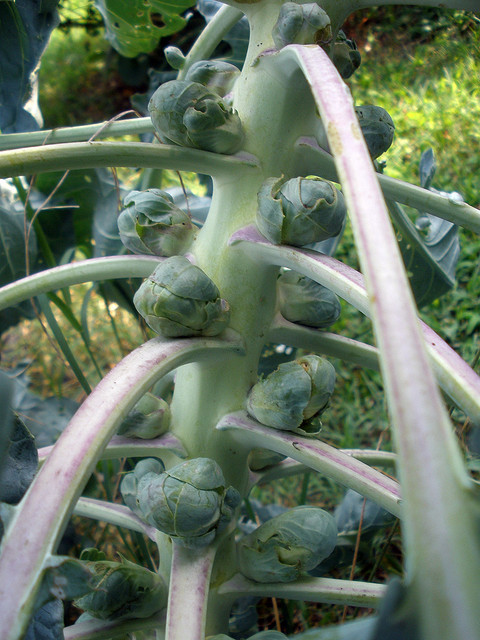Brussels Sprouts in the Garden and Kitchen
This vegetable is easy to grow, loaded with nutrients, and—when cooked well—delicious

Brussels sprouts (Brassica oleracea var. gemmifera) were discovered in the fourteenth century near Brussels, Belgium—hence their name. Like the rest of the cole crop family—which includes cabbage, kale, broccoli, and kohlrabi, they’re a cool-weather lover that can be grown both in the spring and the fall.
Not only are brussels sprouts cold-tolerant, but a couple of kisses from frost on their darling little heads makes them all the sweeter. This is also true for the other brassicas in the family, like broccoli and cauliflower. If you’ve never grown (or seen) them and you happen to come across a vegetable plant that looks as if someone glued teeny-tiny cabbages onto a tall stalk, it’s probably brussels sprouts.
Planting guide
Brussels sprouts like their soil fertile, well-drained, and a little acidic. Plant them where they’ll receive full sun, and keep them evenly watered for best production. In mild winter climates (such as my own), brussels sprouts are planted from seed directly into the garden bed late in the summer or early in fall. Direct seeding works just fine as long as the soil is warm enough (over 50°F).
In warm areas, brussels sprouts are harvested in the late winter through the early spring. If you live in a cold winter climate, you’ll want to start them indoors in winter and transplant the seedlings outdoors in the spring. You’ll be harvesting from late summer through the fall.
 |
 |
Tips on harvesting
Brussels sprouts need a generous amount of time to mature—about 100 days, and often more. They’re harvestable anywhere from about 90 days to 160 days depending on the variety.
They’re rather accommodating plants, and once they’re mature, you can harvest them when they’re needed. After the appropriate amount of time has passed, you’ll notice the leaves are turning yellow, and the bottom heads will be one to two inches in diameter.
That’s your signal that they’re ready for your kitchen. Starting at the bottom of the plant, gently pop the off the heads and stop collecting them when you reach an area on the stalk where they are still quite small. If you’d like them to mature all at once, simply pinch the tip off of the plant when you see sprouts beginning to form on the stalk. This encourages the little sprouts to swell.
Thoughts on cooking with brussels sprouts
Brussels sprouts have a rather poor reputation as far as tasty vegetables go, and there’s a good reason for that: bad cooks. I will be the first one to admit that my first (and second and third) introduction had me hiding them discreetly in napkins and handing them under the table to the family dog. The problem—like so many other things in life—is timing.
If brussels sprouts are overcooked (and they often are) they become seriously unpleasant both to the nose as well as the palate. However, when gently steamed and topped with a garlic butter or other sauce such as a hollandaise, their sweet, nutty flavor is allowed to come through. If you’ve had a less-than-ideal experience with brussels sprouts on your plate, perhaps knowing that they’re loaded with fiber, vitamins A and C, and folic acid are good enough reasons to try your hand at preparing them for dinner.
Fine Gardening Recommended Products

Razor-Back Potato/Refuse Hook
Fine Gardening receives a commission for items purchased through links on this site, including Amazon Associates and other affiliate advertising programs.

The New Organic Grower, 3rd Edition: A Master's Manual of Tools and Techniques for the Home and Market Gardener, 30th Anniversary Edition
Fine Gardening receives a commission for items purchased through links on this site, including Amazon Associates and other affiliate advertising programs.

A.M. Leonard Deluxe Soil Knife & Leather Sheath Combo
Fine Gardening receives a commission for items purchased through links on this site, including Amazon Associates and other affiliate advertising programs.







Comments
Log in or create an account to post a comment.
Sign up Log in